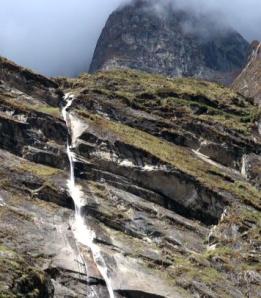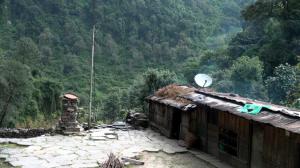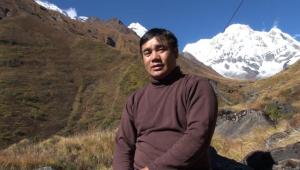Lighting the Way: How the PAYGo Solar Industry is Expanding to Other Life-Changing Products
This article accompanies a documentary film made by the author during a trip to Nepal in the Summer of 2012. The film is available online at poweringthetopoftheworld.wordpress.com.
Amongst the Mountain passes of the Himalayas, a huge challenge is being faced. Draped over the slopes and plains lying at the base of the tallest mountains in the world,Nepal is facing a conundrum which has faced every nation on earth and been the stumbling block of some of history’s greatest civilisations. How to provide energy for a growing and rapidly urbanising population?
Nepal is blessed with tremendous rivers which snake their way through the hills, down into the great expanse of the Indian subcontinent. Yet the power of these waters has been allowed to rush past the people of Nepal and the huge potential that these rivers hold has yet to be tapped.

Huge waterfalls cascade down the slopes of the Himalayas.
Communities living high in the mountains of Nepal have long seen the potential power of the thundering waterfalls that they live beside, and for centuries have taken advantage of nature’s energy. Small watermills, or Ghats have long made life easier for the farming communities of Nepal, grinding their grains. Such ingenuity has progressed into the modern age and communities have harvested the power of water to provide for the modern needs of families. Electric lighting and satellite TV have crept into the lives of the Nepalese through almost 3,000 Community hydro projects that dot the mountainous landscape of Northern Nepal.

Satellite TV is a common sight even in the most isolated mountain valleys.
Yet, such projects are not as perfect as they may seem at first. With few uses for the power other than lighting and TV for a few hours in the evening, the economics of these systems are very difficult to justify. ”We need new technology to increase the end use of micro-hydro in the villages” suggests Jeewan Prasad Thanju, a civil engineer at e-RG Nepal, a hydropower consultancy, ”if technology is available which can use the power for long periods, then it will be profitable”.
However, where uses have been found, they can quickly outstrip supply. Jung Bahadur Gurung, the operator at Chhomrong Community Hydro Project sees the other side to this issue. This micro-turbine powers a small settlement in the Chhomrong Khola valley of the Annapurna Himalayas. Trekkers have allowed this village to prosper and now guesthouses dot the hillside. “Since people have been able to afford appliances, we constantly have to turn the power off, because we can’t meet everyone’s needs.” Yet the village doesn’t have the money to build a larger plant, and the geography makes transporting any bigger equipment into the village very difficult. On these paths, not even donkeys are able to travel, meaning all supplies are carried by foot.

Jung Bahadur Gurung at the Chhomrong micro-hydro plant.
Higher up the mountain, Man Prassad Grg has bigger issues to deal with. The small hydro plant he built himself at the base camp to Machapuchare peak frequently breaks and only operates in the summer at the best of times. “For six months the pipes stay frozen, so there’s no power and the pipes crack. Steel pipes would be better but there’s no way we can transport them up here.”

Man Prassad Grg at Machapuchare base camp.
As the rivers of the Himalayas flow down into the great plains of the Terai, it passes communities unable to tap into the energy of this great mass of flowing water. Although unable to build hydro plants, the flat terrain has made it easier for the government to provide electricity from the national grid to these areas. In a small shabby office in downtown Kathmandu, Dev Sharma Poudel, a director at the Nepal Electricity Authority (NEA), explains the issues facing the country, to the background of horns blaring and engines revving on the crowded streets outside.
“If we don’t have electricity we can’t expect economic growth… So we are trying to build [hydropower] capacity fast by giving licenses to private companies”. But it’s been a slow start in trying to encourage these companies to invest. Most Nepalese enterprises have little capital to invest in the huge upfront cost of hydropower. Even more challenging is how they can recoup their investment whilst following the government’s demands on how electricity should be charged.
The Nepali government wants to bring affordable electricity to as many people as possible and so demands that hydropower developers give the lowest cost electricity to the poorest and therefore smallest consumers. This is the opposite of how most countries design their electricity market; with the largest consumers normally getting the cheapest rate. This conventional tariff structure allows the high marginal cost of connecting an additional small consumer to be compensated for, whilst encouraging larger consumers to consume more, where the marginal costs for the electricity supplier are low. Therefore, the tariff structure being imposed by the government in order to bring electricity to the largest number of people is destroying the business case for many developers which means plants are not built and no-one gets electricity.
More recently a new idea has been floated. Just across the border in India there are many companies eager to supply the huge shortages being faced in the Indian states of Uttar Pradesh and Bihar. These companies have the money and resources to build new plants, but the vast majority of the power that these new dams will generate will literally pass over the heads of the Nepali’s and into India, leaving many Nepali communities with a sense of injustice.

Pylons stretch over Nepal’s mountainous terrain.
Something drastically needs to be done. Nepal has a huge trade deficit, not helped by the need to import oil from India to power the multitude of diesel generators which people own to cope with daily power cuts. As Mr Poudel sees it: “you may have heard that in Jumla and Jumsum we have apple trees, but… we are importing Indian apples and Chinese apples. Why?”
Given the urgency of the situation, he argues that something must be done immediately. “If we can’t fund hydro ourselves, it’s better to allow private companies to develop them, because after 25 years all these projects will be given back to the Nepali government. It will be a big asset. Now the rivers are just flowing…”
But many others believe the development of huge hydropower projects by Indian investors will wreak havoc with local ecosystems whilst local communities will see few benefits. Some also worry about Nepali politicians being manipulated by neighbouring countries over these large financial investments. A worry which is particularly pertinent in a country that ranks towards the bottom of the world corruption index.
Nepal lies at a tipping point in its energy sector. Will the country continue to languish in a state of constant blackouts and costly alternatives, or will it be able to make the most of the resources it has, and, in the words of one hydropower professional, be able to create “Water Money”?
Energy efficiency is often described as the “no-brainer” or “win-win” of clean energy. You use less energy, lowering carbon emissions, and save money at the same time. But looking beyond the individual act, can energy efficiency really save carbon emissions?
Say you’re a company that makes widgets, and you find a way to reduce the energy needed to make a widget. You can now make widgets cheaper since your energy bills are lower. Now, your core business is widget making, so what are you going to do with this money you’ve saved? Probably make more widgets. And so you’re not really saving any energy at all.
Now this is known as Jevons’ paradox or the rebound effect [1]. But is it true in today’s society? Will there be a market for more widgets? Or will your widgets push another company out of the market that will then close down their factory and stop using electricity to make widgets? Luckily, lots of people have looked at this and someone has gone through all the literature already, with a nice summary presentation here [2].
From the conclusions of this study, we do need to worry about the rebound effect reducing the true energy savings (and hence carbon savings) of an energy efficiency measure, but energy efficiency still is effective. For industry it’s less of a problem since energy is often not a major cost in a factory and so reducing this has minimal effect on production. For consumers, less that 30% of the energy savings are likely to be negated by a direct increase in energy use. However, looking economy wide (i.e. where else the money is spent) is more uncertain and there’s a lack of good studies, but it has been estimated that a 50% rebound effect could be possible, although there is little evidence that efficiency measures increase consumption (known as backfire).
But to simplify things a little, let’s consider the carbon emissions of an individual homeowner. Is buying energy a particularly carbon intensive use of money? And what can you do with that money that you saved from buying that shiny new LED lightbulb and still feel good about yourself?
Carbon intensity of buying UK electricity:
– Cost of electricity [3] = 0.14 £/kWh
– Carbon intensity of electricity [4] = 0.547 kgCO2eq /kWh
– Therefore: Carbon intensity of money spent on electricity = 3.9 kgCO2eq/£
So for every pound you spend on electricity in the UK, you’re producing around 4kg of carbon emissions.
The savings that provide the “win-win” of many energy efficiency measures will inevitably be spent elsewhere, so what else might you spend your money on?
So for now it really is a win-win. Buying gas and electricity are extremely carbon intensive ways to spend your money, and doing almost anything else with that money is going to reduce emissions. As the cost of electricity and gas increase, and we start to use cleaner generators in the grid and more efficient boilers in our homes, the carbon intensity of buying electricity and gas will reduce and we may find a time when we need to watch what we spend our saved pennys on if we really want to help the environment.
Also, we need to keep in mind the amount of money spent. For example, spending money on flights is a lot of money spent on a very carbon intensive activity. To save the carbon equivalent of this, you would have to cut your electricity bill by more than 10% [5].
So it seems that energy efficiency really can help in the reducing our emissions and combatting climate change. Just don’t justify that holiday to Spain on the basis that you bought a few new lightbubs.
Why have some cultures over the course of history managed to create sustainable communities while others exploited the resources to maximum effect, branching out to new worlds as soon as they could?
The popularist Jared Diamond, and his rather more rascist predecessors such as Elsworth Huntington, have argued that climate and geography, and the resources (in crops and animals) that these provide, were the determining factors in limiting the development of certain societies. This boils down to the idea that the highly productive crops and very useful animals which were to be found around the fertile crescent in the middle east, and which spread to the rest of Eurasia, gave these societies a distinct advantage. This subsequently allowed them to conquer much of the rest of the world through the technology this advantage allowed them to develop (See Guns, Germs and Steel by Jared Diamond).
The theory of Environmental Determinism lost favour towards the middle of last century (for good reason, since it has historically been used to justify some pretty terrible colonial activities, and arguable still allows for retrospective justification in Diamond’s framing[1]). Instead, mainstream theory moved towards the idea that development of societies was more heavily influenced by culture and community interaction with their neighbours, rather than in fixed stages which could be accelerated through with the help of a favourable environment (see for example Frank Boas).
So how does this relate to my first post “We are hunters”? If we take the environmental determinists view, then as long as society has resources to exploit, it will do so to the greatest extent possible. We will continue to deplete our resources and pollute our atmosphere until the moon becomes economic to mine and living in Space seems like a good option (the Disney film Wall-E builds thought provoking narrative around this idea). Essentially, we have no motivation to change, and we won’t.
Diamond argues this is not the case, instead proposing that responsible exploitation can allow us a sustainable future. He cites examples such as Japan’s Shungong dynasty who banned deforestation, maintaining the environment. But as pointed out by J R McNeill[2] this was only possible due to their exploitation of minority communities within Japan (such as those on outer islands) and later in neighbouring countries through Japanese imperialism, as well as suppression of their own community through abortions and infanticide. And looking at climatic environmental degradation, is it really likely that a profit driven oil company will suddenly stop drilling for oil on its own accord? And can we really expect nation states to agree on the level of emission reductions necessary to truly limit the impact of climate change, considering the effect such policies could have on their own economies?
But environmental pessimism won’t help. What if we instead take a Boasian view of societal development? Frank Boa suggested that culture plays a much more important role in how societies progress and develop. Perhaps by thinking of global development through the lens of a changing culture, rather than assuming that the human race is designed to consume, we can maintain some optimism in our future[3].
Maybe the answer to the Energy and Climate Change problem is not in developing “benign” technological solutions (if that is ever possible), but instead to work to develop our culture so that we no longer exist to exploit, but instead exist to sustain. Any ideas on how to do that without throwing away our freedom?
Further, better informed reading:
http://enva320spring2011.wiki.usfca.edu/file/view/Sustainable+Survival.pdf
http://louisproyect.org/2010/04/19/the-collapse-of-jared-diamond/
Guns, Germs and Steel, Jared Diamond
Guns Germs and Steel in TV documentary form: https://www.youtube.com/watch?v=cLJfZOyFpZo
Collapse, Jared Diamond
A very interesting paper which looks at how the climate change narrative is taking an environmentally deterministic view of adaptation.
[1] As one irate blogger summarised Diamond’s thesis: “There, but for the grace of geography, go I.” http://louisproyect.org/2010/04/19/the-collapse-of-jared-diamond/
[3] This clearly also has some implications on evolution, and what drives a species to continue, but I’m going to ignore this.